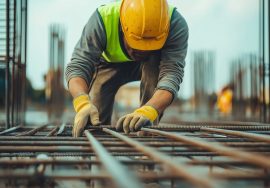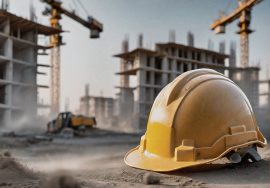How Innovative Project Solutions Enhance Safety Protocols
How Innovative Project Solutions Enhance Safety Protocols

In the construction industry, safety is a top priority. With high-risk environments and complex tasks, maintaining a safe workplace is essential for protecting workers and ensuring smooth project execution. Innovative project solutions, fueled by advancements in technology and smarter methodologies, are transforming how safety protocols are designed and implemented. By leveraging these innovations, construction companies can enhance safety, reduce risks, and create safer work environments for all involved.
1. Real-Time Monitoring with IoT Devices
The Internet of Things (IoT) has revolutionized how safety is managed on construction sites. IoT devices, such as smart sensors and wearables, can monitor real-time conditions on-site and alert workers and managers about potential hazards.
- Wearable Safety Technology: Devices like smart helmets, vests, or wristbands can monitor workers’ health metrics, such as heart rate, body temperature, and fatigue levels. They can send alerts when signs of distress are detected, reducing the risk of accidents.
- Environmental Sensors: Sensors can detect unsafe environmental conditions such as gas leaks, temperature fluctuations, or machinery malfunctions. These devices can automatically trigger alarms or safety measures to protect workers.
- Real-Time Location Tracking: IoT-enabled devices can help track worker locations on-site, ensuring that no one is in hazardous areas when dangerous activities occur, such as demolition or heavy lifting.
By continuously monitoring conditions and worker health, IoT technology allows for immediate responses to emerging safety risks.
2. Robotics for Hazardous Tasks
Robots are increasingly being used in construction to perform high-risk tasks, which significantly reduces human exposure to danger. These tasks include heavy lifting, welding, or working in environments with hazardous materials.
- Automated Machinery: Machines and robots can perform repetitive and physically demanding tasks like lifting heavy materials, digging, or handling toxic substances, reducing the potential for injuries.
- Drones for Inspections: Drones are used to inspect hard-to-reach or dangerous areas, such as high scaffolding, roofs, or building exteriors. This reduces the need for workers to physically access hazardous areas.
By using robotics and automated machinery, construction sites can minimize human exposure to dangerous situations, leading to a safer environment for workers.
3. Artificial Intelligence for Predictive Safety Analytics
Artificial intelligence (AI) plays a crucial role in enhancing construction site safety by using predictive analytics to foresee potential safety hazards before they arise.
- Predictive Maintenance: AI-powered systems can analyze equipment data to predict when machinery or tools might fail, allowing for preventative maintenance and reducing the risk of malfunctions during operation.
- Risk Assessment Models: AI can analyze historical data from previous projects to identify patterns and predict potential risks, such as specific weather conditions, equipment failures, or human errors. This proactive approach enables teams to take preventive measures in advance.
- Smart Safety Protocols: AI can help generate smart safety guidelines for specific tasks, using data and analysis to ensure that safety measures are tailored to the specific risks of each project or phase.
By leveraging AI’s predictive capabilities, construction teams can anticipate and address potential safety hazards, reducing the likelihood of accidents and improving overall safety protocols.
4. Augmented Reality (AR) for Safety Training and Site Navigation
Augmented reality (AR) technology is transforming safety training and site navigation. AR allows workers to engage in immersive training experiences and gain a clear understanding of potential hazards before stepping onto the construction site.

- Safety Training Simulations: With AR, workers can undergo realistic safety training simulations without being exposed to real-world risks. They can practice responding to dangerous situations like fires, equipment malfunctions, or structural collapses in a controlled, virtual environment.
- On-Site Hazard Identification: AR glasses or apps can overlay digital safety information on a worker’s view of the physical site, highlighting potential hazards, safety equipment locations, and emergency procedures. This allows workers to be more aware of risks in their immediate surroundings.
- Virtual Site Walkthroughs: AR enables project managers and safety officers to conduct virtual site inspections and spot potential safety issues before construction begins, helping them plan mitigation strategies in advance.
By integrating AR into safety training and daily operations, construction companies can enhance worker awareness and preparedness, preventing accidents before they occur.
5. Enhanced Communication and Collaboration Tools
Effective communication is critical for maintaining safety on construction sites. Innovative tools, such as cloud-based platforms and mobile apps, are improving the way safety information is shared and accessed by workers, project managers, and safety officers.
- Cloud-Based Safety Management: Cloud platforms provide a centralized location for storing safety reports, incident logs, and real-time updates. Project managers and safety officers can access this data from anywhere, allowing them to monitor the site and address issues more quickly.
- Mobile Safety Apps: Mobile apps enable workers to report safety concerns instantly, whether it’s a hazardous situation or a safety protocol violation. These apps also offer real-time communication with supervisors, ensuring quick responses and mitigation actions.
- Collaborative Platforms: Team collaboration tools help safety managers share updates and communicate with workers, ensuring that everyone is aware of safety protocols, changes to schedules, or new regulations.
By using these innovative communication and collaboration tools, construction teams can work together to maintain a high level of safety throughout the project.
6. Smart PPE (Personal Protective Equipment)
Personal protective equipment (PPE) is a staple of construction site safety. However, with the integration of smart technologies, PPE is becoming more effective in keeping workers safe.
- Smart Helmets: Equipped with sensors, smart helmets can monitor the worker’s condition and the surrounding environment, providing feedback on air quality, temperature, and proximity to hazardous areas.
- Connected Safety Vests: These vests can track workers’ movements and alert supervisors if a worker enters a dangerous area or if they are involved in an accident.
- Smart Boots: Wearable footwear can detect and alert workers to unsafe surfaces or if they’re walking in areas prone to slipping or falling.
With these enhanced PPE devices, construction sites can offer real-time safety alerts and ensure that workers are always protected.
Conclusion – Safety Protocols Innovative Solutions
Innovative project solutions are significantly improving safety protocols across the construction industry. From IoT-enabled wearables and AI-driven risk assessments to augmented reality training and smart PPE, these advancements help create safer work environments, reduce accidents, and streamline safety practices. By integrating these innovations, construction companies can stay ahead of safety challenges, protect their workforce, and ensure successful project outcomes. The future of construction is not only about efficiency and quality but also about prioritizing the health and well-being of everyone involved.
External Resources – Safety Protocols Innovative Solutions
Indian Green Building Council (IGBC)
- The IGBC promotes sustainable building practices in India. They offer guidelines and certifications that ensure construction projects meet environmental standards. Explore their resources at Indian Green Building Council.
Construction Industry in India
- One of India’s largest construction and engineering companies, L&T Construction provides services including project management, cost control, and engineering consultancy. For detailed information on their offerings, visit. Construction Industry in India
Read more related articles to enhance your knowledge and make informed decisions
10 Essential Steps in the Building Construction Process
How to Choose the Right Materials for Your Construction Project







